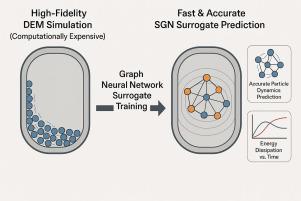加速颗粒动力学模拟:复杂高能球磨的图神经网络代理
IF 4.6
2区 工程技术
Q2 ENGINEERING, CHEMICAL
引用次数: 0
摘要
虽然离散元法(DEM)提供了高保真的颗粒过程(如高能球磨),但在探索放大所需的广泛参数空间时,其计算成本可能会变得令人望而却步。这一限制阻碍了对机械化学等新兴应用至关重要的快速设计和优化周期。代理建模为克服这些计算障碍提供了一条有希望的途径,然而现有的方法往往难以准确地表示铣削设备典型的复杂、移动的边界条件。在这项工作中,我们利用了一个为Emax磨机的高能移动边界机制量身定制的签名距离函数图神经网络(SGN)代理。在DEM数据的训练下,SGN联合预测递归滚出的粒子运动学和与力学化学相关的全局量,即全局耗散能量。该模型对未见的运动轨迹和适度的jar形编辑具有很强的泛化能力,无需再训练,同时运行的时间步长比DEM所需的时间步长100倍以上。在仅cpu的比较中,它实现了至少6.6倍的时钟加速。该方法为高能球磨设备的仿真、分析和优化设计提供了一种强有力的、有前景的技术。本文章由计算机程序翻译,如有差异,请以英文原文为准。

Accelerating granular dynamics simulations: A graph neural network surrogate for complex high-energy ball milling
While the Discrete Element Method (DEM) provides high-fidelity insights into granular processes like high-energy ball milling, its computational cost can become prohibitive when exploring extensive parameter spaces required for scale-up. This limitation hinders the rapid design and optimization cycles crucial for emerging applications, like mechanochemistry. Surrogate modeling offers a promising path to overcome these computational barriers, yet existing approaches often struggle to accurately represent the complex, moving boundary conditions typical of milling equipment. In this work, we leverage a Signed Distance Function Graph Neural Network (SGN) surrogate tailored to the high-energy, moving-boundary regime of the Emax mill. Trained on DEM data, the SGN jointly predicts particle kinematics for recursive roll-out and a mechanochemistry-relevant global quantity, the global dissipated energy. The model exhibits strong generalization to unseen motion trajectories and moderate jar-shape edits without retraining, while operating with a timestep over 100x larger than required by DEM. In a CPU-only comparison, it achieves a minimum of 6.6× wall-clock speedup. This approach provides a powerful and promising technique for the simulation, analysis, and design optimization of high-energy ball milling equipment.
求助全文
通过发布文献求助,成功后即可免费获取论文全文。
去求助
来源期刊

Powder Technology
工程技术-工程:化工
CiteScore
9.90
自引率
15.40%
发文量
1047
审稿时长
46 days
期刊介绍:
Powder Technology is an International Journal on the Science and Technology of Wet and Dry Particulate Systems. Powder Technology publishes papers on all aspects of the formation of particles and their characterisation and on the study of systems containing particulate solids. No limitation is imposed on the size of the particles, which may range from nanometre scale, as in pigments or aerosols, to that of mined or quarried materials. The following list of topics is not intended to be comprehensive, but rather to indicate typical subjects which fall within the scope of the journal's interests:
Formation and synthesis of particles by precipitation and other methods.
Modification of particles by agglomeration, coating, comminution and attrition.
Characterisation of the size, shape, surface area, pore structure and strength of particles and agglomerates (including the origins and effects of inter particle forces).
Packing, failure, flow and permeability of assemblies of particles.
Particle-particle interactions and suspension rheology.
Handling and processing operations such as slurry flow, fluidization, pneumatic conveying.
Interactions between particles and their environment, including delivery of particulate products to the body.
Applications of particle technology in production of pharmaceuticals, chemicals, foods, pigments, structural, and functional materials and in environmental and energy related matters.
For materials-oriented contributions we are looking for articles revealing the effect of particle/powder characteristics (size, morphology and composition, in that order) on material performance or functionality and, ideally, comparison to any industrial standard.
 求助内容:
求助内容: 应助结果提醒方式:
应助结果提醒方式:


